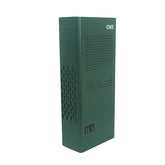Understanding Wi-Fi Jammers: How Do Wi-Fi Signal Blockers Work?
Wi-Fi has become an integral part of our daily lives, providing wireless connectivity for various devices. However, there are instances where individuals may resort to using Wi-Fi jammers or signal blockers to disrupt or block Wi-Fi signals. This article aims to explore the working principles behind WiFi jammers and how they interfere with Wi-Fi signals.
Wi-Fi Signal Basics:
Before delving into Wi-Fi jammers, it's important to understand the basics of Wi-Fi signals, including frequency bands, modulation techniques, and signal propagation.

Wi-Fi Jamming Techniques:
Wi-Fi jammers utilize different techniques to disrupt or block Wi-Fi signals. This section discusses the following jamming methods:
a. Deauthentication Attacks: Exploiting vulnerabilities in the 802.11 protocol to force devices to disconnect from Wi-Fi networks.
b. Denial-of-Service (DoS) Attacks: Flooding Wi-Fi channels with excessive traffic or noise, rendering the network unusable.
c. RF Interference: Emitting radio frequency interference to disrupt Wi-Fi signals, causing packet loss and degradation of signal quality.
Wi-Fi Jammer Operation:
This section explores the inner workings of Wi-Fi jammers, including the components and mechanisms involved. Topics covered include:
a. Signal Generation: Generating interference signals on Wi-Fi frequencies using oscillators or amplifiers.
b. Transmission Power: Adjusting the power levels of the jamming signal for effective signal disruption.
c. Frequency Range: Targeting specific Wi-Fi frequency bands (2.4 GHz or 5 GHz) to disrupt network communications.
Legality and Ethical Considerations:
The use of Wi-Fi jammers raises legal and ethical concerns. This part examines the legality of WiFi signal blockers in different jurisdictions and highlights the potential risks and consequences associated with their use.
Impact and Mitigation:
The impact of Wi-Fi jammers on networks, devices, and users is discussed, including potential security vulnerabilities and countermeasures. It also explores methods to mitigate the effects of Wi-Fi jamming attacks.
Future Trends and Conclusion:
The article concludes by discussing emerging trends in Wi-Fi jamming technology and the importance of striking a balance between network security, privacy, and responsible use of Wi-Fi signal blockers.
By understanding how Wi-Fi jammers work, readers can gain insights into the potential risks and challenges associated with wireless network security and take appropriate measures to protect their Wi-Fi networks.













